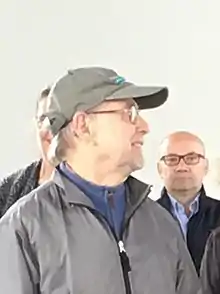William G. Tucker
William G. Tucker RA (born 28 February 1935) is a modernist British sculptor and modern art scholar.
William Tucker | |
|---|---|
 | |
| Born | 28 February 1935 Cairo, Egypt |
| Nationality |
|
| Education | |
| Elected | Royal Academy, 1992 |

Biography
Tucker was born to English parents on 28 February 1935 in Cairo, Egypt.[1] In 1937, his family returned to England, where Tucker was raised. At the University of Oxford he studied history from 1955 to 1958. He moved to London and studied sculpture both at the Central School of Art and Design and at Saint Martin's School of Art,[1] where Anthony Caro was teaching. In 1965 he was one of nine sculptors included in the important New Generation: 65 exhibition at the Whitechapel Gallery in London, and one of seven from that exhibition whose work was included in the Primary Structures: Younger American and British Sculptors exhibition at the Jewish Museum in New York in the following year.[2] Tucker spent two years as a Gregory Fellow at the Fine Arts Department of the University of Leeds (1968–70) and represented Britain at the 1972 Venice Biennale. In 1974 he published The Language of Sculpture (Thames & Hudson, London), which was released in the United States in 1978 as Early Modern Sculpture (Oxford University Press.
He moved to New York in 1978 and taught at Columbia University and at the New York Studio School of Drawing, Painting and Sculpture. He received a Guggenheim Fellowship for sculpture in 1981 and a National Endowment for the Arts fellowship in 1986. Tucker became an American citizen in 1985. He served as co-chairman of the Art Program at Bard College.
He was elected to the Royal Academy of Arts in 1992.[3]
In 2010, Tucker was a recipient of the Lifetime Achievement in Contemporary Sculpture award of the International Sculpture Center.[4]
In 2011, Tucker was elected an honorary National Academician, National Academy Museum, New York.
Recent one-person museum exhibitions included Tucker: Mass and Figure at the Museo de Bellas Artes de Bilbao in 2015,[5] and William Tucker at the Kunstmuseum Winterthur in Switzerland in 2016.[6]
Footnotes
- Daniel E. Mader (2003). Tucker, William. Grove Art Online. Oxford: Oxford University Press. doi:10.1093/gao/9781884446054.article.T086483. (subscription required).
- Juliff, Toby (2018). "A New Generation of British Art: A Problem of Provincialism". Sydney: Australian and New Zealand Journal of Art. p. 125–145.
- William Tucker RA (b. 1935). London: Royal Academy of Arts. Accessed October 2020.
- "Lifetime Achievement in Contemporary Sculpture Award page". International Sculpture Center. Retrieved 24 January 2010.
- "Tucker. Mass and Figure". Museo Bibao. Retrieved 10 September 2016.
- "William Tucker". Kunstmuseum Winterthur. Retrieved 10 September 2016.
Further reading
- Arts Council of Great Britain, The condition of sculpture, a selection of recent sculpture by younger British and foreign artists [introduction by William Tucker], London, Arts Council of Great Britain, 1975.
- Brooklyn Museum, Working in Brooklyn, sculpture: Donald Lipski, Chris MacDonald, John Monti, Tom Otterness, Judy Pfaff, Ray Rapp, Alan Saret, Art Spellings, William Tucker, Christopher Wilmarth, Brooklyn, N.Y., Brooklyn Museum, 1985.
- Elderfield, John, Against the grain, contemporary art from the Edward R. Broida collection, New York, Museum of Modern Art, 2006.
- Lynton, Norbert, William Tucker, sculptures, London, Arts Council of Great Britain, 1977.
- Rosenfield Lafo, Rachel, William Tucker, Horses, Lincoln, MA, DeCordova Museum and Sculpture Park, 2006.
- Sleeman, Joy, The sculpture of William Tucker, Aldershot, Hampshire [England], Lund Humphries, 2007.
- Tucker, William, William Tucker, Gods: five recent sculptures, London, Tate Gallery, 1987.
- Tucker, William, William Tucker, sculpture 1970-73, London, Arts Council of Great Britain, 1973.
- Tucker, William, William Tucker, the American decade, 1978-88, Mountainville, N.Y., Storm King Art Center, 1988.